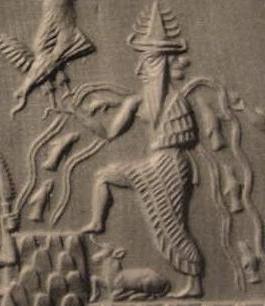Code of Hammurabi
The Code of Hammurabi is one of the oldest deciphered writings of significant length in the world. Created by Babylonian king Hammurabi in the 18th century BCE, it is a comprehensive set of 282 laws, inscribed on a stele. The Code covers a range of topics, including trade, family law, labor law, and property law, providing insights into the social, economic, and legal structures of ancient Mesopotamia.
Origins and Discovery[edit | edit source]
The Code was commissioned by Hammurabi after he took power in Babylon, aiming to unify the diverse groups within his empire and provide a common legal framework. The stele containing the Code was discovered in 1901 by a team led by Jean-Vincent Scheil in Susa, Iran, where it had been taken as plunder over a millennium after its creation.
Content[edit | edit source]
The laws inscribed on the stele are written in the Akkadian language, using cuneiform script. They begin with a prologue that credits Hammurabi with establishing justice in the land, followed by the laws themselves, and conclude with an epilogue that invokes divine retribution against those who would disobey the laws. The Code is notable for its "an eye for an eye" philosophy, although this principle was applied differently depending on the social status of the accused and the victim.
Legal Principles[edit | edit source]
The Code of Hammurabi is significant for its early examples of legal principles that are foundational to modern legal systems. These include the presumption of innocence, the right to present evidence in one's defense, and the establishment of a judicial process for resolving disputes. The laws also detail various penalties for specific crimes, ranging from fines to physical punishment and death.
Impact and Legacy[edit | edit source]
The influence of the Code of Hammurabi extends beyond the ancient Near East. It is considered a precursor to later legal codes in the region, including the Mosaic Law of the ancient Israelites. Its principles can be seen in the legal systems of many cultures and have contributed to the development of international legal standards.
Preservation and Study[edit | edit source]
The stele on which the Code is inscribed is housed in the Louvre Museum in Paris. It remains an important object of study for historians, archaeologists, and legal scholars, providing valuable insights into ancient Mesopotamian society.
See Also[edit | edit source]
Navigation: Wellness - Encyclopedia - Health topics - Disease Index - Drugs - World Directory - Gray's Anatomy - Keto diet - Recipes
Search WikiMD
Ad.Tired of being Overweight? Try W8MD's physician weight loss program.
Semaglutide (Ozempic / Wegovy and Tirzepatide (Mounjaro / Zepbound) available.
Advertise on WikiMD
WikiMD is not a substitute for professional medical advice. See full disclaimer.
Credits:Most images are courtesy of Wikimedia commons, and templates Wikipedia, licensed under CC BY SA or similar.Contributors: Prab R. Tumpati, MD






